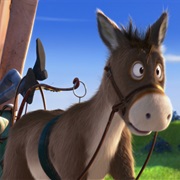
Other physical traits include narrow shaped hooves which are particularly useful when the animal is travelling over rough terrain. They also have a stripe across their shoulders. Male donkeys are called jack while females are referred to as jenny.ĭonkeys have short fur on both their manes and tails as well as a dark stripe running along their backs from the animal's head down to its tail. In poorer countries donkeys have long been utilized as efficient beasts of burden therefore they have shorter lifespans than similar animals living less regimented and more comfortable lifestyles in countries such as the U.S. A donkeys lifespan is largely dependent on the animal's living conditions. A fully grown donkey may reach a weight of between 180 and 1,060 pounds. Typically in terms of height these domesticated animals may measure between 31 and 63 inches at their withers (the ridge between a donkey's shoulder blades). Depending on factors such as breeding these hardy animals come in a range of sizes. This is another reason why they are able to handle carrying heavy loads over long distances.Īlso commonly referred to as an ass or burro, the donkey is characterized by the loud braying sounds it makes as well as the large size of its ears which are shaded darker at the tips as well as at the base of its ears. Mules are said to have harder hooves than that of horses. Male mules are called jack or john while females are referred to as molly.

Mules are used in a variety of industries and environments throughout the world including mining, farming, and transporting heavy loads as draft animals. The two animals also display subtle physical differences in regards to the appearance of their teeth, neck shape, and coat. Mules are characterized by their short manes and heads as well as thin legs. Conversely, the tail of a donkey is coarse and looks much more similar to that of a cow's. This is also true in terms of the mule's tail which looks a lot like that of a horse's tail. This is particularly true when it comes to examining the mule's ears which are smaller in size than a donkey's and more in line with the physical structure of horse ears. Physically they more closely resemble horses more than do their donkey counterparts. Mules are hybrid animals which are born after a female horse (or mare) mates with a male donkey (called a jack). In order to better curb the aggressive behavior of male mules towards females, most animals are castrated. Another difference between mules and donkeys involves the mules' ability to jump up from a standing position which is a feat that donkeys are incapable of performing.ĭue to the fact that the ability to reproduce is one of the major biological differences between mules and donkeys, it's interesting to note that while male mules may mate these animals don't have the haploid cells which are required in order to successfully produce offspring. Mules are also regarded to be better at physically demanding work because they have more stamina. This is due to the fact that donkeys are known for losing patience while struggling with excess weight. Although both animals are used for labor intensive work mules are widely thought to be better at handling heavy loads than donkeys. Donkeys are also born with 62 chromosomes while mules have 63.

Since they cannot mate mules are incapable of producing offspring.

In terms of basic biological make up one of the main differences between these two very similar animals is the fact that while donkeys can reproduce, mules are infertile.


 0 kommentar(er)
0 kommentar(er)
